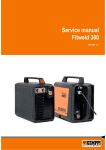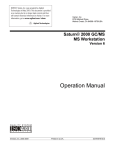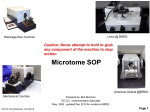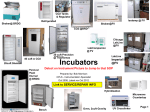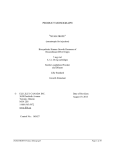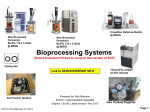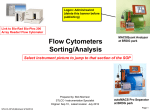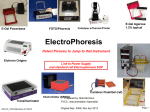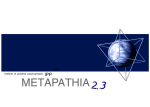Download Chromatography-Gas - St. Louis Community College
Transcript
Buck 310 GC PeakSimple Software Chromatography- Gas Standard Operating Procedures (Preliminary) (Detect Instrument Picture to Jump to that section of SOP) Prepared by: Bob Morrison (STLCC-CPLS Instrumentation Specialist) and Mike Davies (NIDUS) Original Nov 10 , Latest Revision Nov 11(add Varian manual ) Agilent/Varian 3800 The GC is in the Bio processing Room along the front windows. It is a Varian 3800CP (pretty fancy when set up correctly) with a flame ionization detector (FID). It has not been used at the college, but it was removed from Covidien's St. Louis plant in working condition. The column will need to be replaced as well as all of the fittings. The college does not have a software package such as Galaxie or TotalChrome at BRDG Park, but the machine's on-board screen allows the user to view results and adjust settings. Hydrogen and/or helium sources will be needed as well. That's all that I know about it, but Denise Heinz may be able to help more either personally or through her company. -Ian Rappold 5/2013 Page 1 STLCC_CPLS;Morrison 6/3/2013 Chromatography: Gas, Buck 310 Small size, full peformance Dimensions: 12.5" wide x 13.5" high x 14.5" deep Ambient to 400°C programmable column oven Mounts up to four detectors Hot link to BUCK 310 Product Brochure…pdf Hot link to Quick Start Guide (SRI ) …pdf Hot link to Gasless Education guide …pdf Hotlink to Free Technical Support at SRI http://www.srigc.com/2005catalog/cat109.htm The Buck 310 portable gas chromatograph is Multi-detector system and can accommodate 2-4 detectors, depending on your combination. There are 9 specific detectors available for the Buck 310 GC. Price is for base unit, without detector(s).. Designed to be durable and portable, the compact 310-series is ideal for operation in the field, E.P.A. and A.S.T.M. methods can be easily performed on-site, even in adverse field environments. A GC with the versatility to meet your lab's specific needs. The unique architecture of the Buck GC systems allow various detector and injector combinations, so each GC can be configured to meet your specific lab requirements. Automated Analyses let the GC do the work so you don't have to -The Buck 310 offers total control of application parameters using PeakSimple software. PeakSimple allows unlimited temperature programming, electronic pressure control, carrier gas pressure, gas valve position, gas solenoid actuation, autosampler control and other options. Just program your application parameters into the computer and let the 310 do the rest. Over 12 different detector options to choose from for optimal measurement results STLCC_CPLS;Morrison 6/3/2013 Page 2 Chromatography: Gas, Buck310 CCD (Catalytic Combustion Detector) STLCC_CPLS;Morrison 6/3/2013 Page 3 Chromatography: Gas, Buck310, PeakSimple Software PeakSimple chromatography data systems consist of hardware and software. The hardware is available as a stand-alone data system for connection to almost any model GC, HPLC, or CE system. The same hardware is supplied as standard equipment with every SRI 8610C, 8610D, 410, and 310 GC. No hardware is installed in your computer, so a notebook or netbook PC may be used instead of a full-sized desktop PC. PeakSimple chromatography acquisition and integration software for http://www.srigc.com/PeakSimple.htm (from SRI Instruments Co. Make detectors) PeakSimple Version 3.88 for Windows Vista downloaded and installed On Stratagene Laptop 11/12/10 by Bob Morrison Set Default COM 1 port ID to “1” under Edit-Overall toolbar STLCC_CPLS;Morrison 6/3/2013 Page 4 Chromatography Gas: Buck310 On/Off main toggle Door must be closed before Oven with operate Open door to Set “pots” before run. Screwdriver: used to turn “pot” set screws for Temp, other parameters. See manual Injection Port LOCAL TOTAL STATUS Temp Over Limit LED STLCC_CPLS;Morrison 6/3/2013 Toggle Switch: Up position to set values. Down position, current readings displayed. TEMP Column of buttons: With toggle in up position, buttons will be used to adjust or calibrate oven temp to ambient level. Page 5 Chromagraphy: GAS, Basic Start Guide, Buck 310 HARDWARE: 1. On the Front panel of the GC, set the toggle switch to the UP position 2. Open the lid of the GC to expose the oven and “pot” set screw holes. 3. Retrieve the screwdriver and insert in the hole or “pot” above the TEMP column. While holding the top (LOCAL) row button, rotate the “pot to the 0000 position. This will indicate tha no increment is set above the current oven ambient/room temperature. 4. Close the GC lid. Press the STATUS row TEMP button and observe that the oven is at ambient temperature. The TOTAL row should show 0000 or close to it. 5. Turn off the GC device and proceed to the SOFTWARE setup which will control the device parameters for run and analysis. SOFTWARE: 1. Download PeaksimpleSoftware to PC, attach RS232 line from GC device to COM port. 2. Turn on GC (toggle), Initiate Peaksimple Software and monitor initialization and communication process between device and software. If initialization fails, Go to PeakSimple Edit option in top toolbar, select Overall, then enter COM port ID where the RS232 connect was made. You may also need to change the type of connection (USB or Serial) on this same panel. Repeat startup process. 3. Select EDIT from the top toolbar, then Channels. Select the Active, Display, and Integrate options next to Channel 1. An “X” will show in the appropriate box. 4. From the EDIT-CHANNELS menu, Select DETAILS, then MAIN for channel 1. In the Control by section, select Temperature. 5. From the EDIT-CHANNELS menu, Select TEMPERATURE and enter the start , delay, and any ramp temperature conditions desired. You may optionally LOAD a saved TEMPERATURE profile or SAVE new or modified TEMPERATURE profiles for this or Page 6 future runs.6/3/2013 STLCC_CPLS;Morrison GC: Startup Screen; Initialization or “Waking-up” Pop-up Window will appear Waking-up Pop-up Window will check connectivity to the GC device, validate COM port for RS232 connections, and test basic parameters. GC: Edit- Channels- to Set Oven Temp and other Parameters Select EDIT- then OVERALL to set or reset COM port ID Select EDIT- then CHANNELS to set temperature and other parameters. GC: Select Channels to Set Oven Temp, other Parameters Select to Activate the ACTIVE, DISPLAY, and INTEGRATE options for Channel 1 and any others in use. GC: On Temp Window, Load old profile or Enter new Data Select EDIT- then CHANNELS- then TEMPERATURE ; LOAD (retrieve a TEMP profile) CHANGE (modify parameters) SAVE (store modified parameters for a future run) GC: Edit-Channels to enter Description and Details Select EDIT- then CHANNELS, then DETAILS To set temperature and other parameters. GC: Set Channels, then Components Select EDIT- then CHANNELS, then COMPONENTS to define Peaks BNC connector for 10 base 2 Ethernet cable Chromatography: Gas, Varian 3800 The Varian CP-3800 GC is Varian's top of line Gas Chromatograph with a flexible platform for single, dual, or three-channel configuration for maximum productivity. Large LCD screen and straightforward user interface for easy viewing and editing of GC parameters. Spacious column oven accommodates three or more columns. Fast heat-up (100°C/min) and rapid cool-down column oven (400°C to 50°C in 4.5 min) allow for faster cycle times and increased productivity. Concurrent installation and operation of up to three injectors and three detectors permanently on the GC. Wide range of injectors and detectors to choose from for the most complicated application. Choose from manual pneumatic control or electronic flow control for all injectors and detectors. Wide range of autosamplers to choose from for complete sample introduction and preparation automation. Humidity 5% to 95% (relative) GC System Type Modular Depth 56 cm Height 53 cm Width 66 cm Power Requirements 101V, 120V, 230V Weight 43 kg It is fully functional as a standalone GC or controlled through the Varian Star Workstation or the Galaxie Chromatography Data System. Hot Link to Varian Brochure … 18 pgs pdf Hot Link to Varian, Basic Instructions ….pdf Hot Link to Varian Laurier Sci User Manual STLCC_CPLS;Morrison 6/3/2013 Page 13 Hot Link to Varian Maintenance/Parts Brochure..pdf Hot Link to Varian 3800 User Manual pdf format (pages included in this document) Chromatography: Gas, Varian , Manual Table of Contents. STLCC_CPLS;Morrison 6/3/2013 Page 14 Chromatography: Gas, Varian 3800, Keyboard/Controls STLCC_CPLS;Morrison 6/3/2013 Page 15 Chromatagraphy: Gas, Varian 3800, Setup, pg 3 STLCC_CPLS;Morrison 6/3/2013 Page 16 Chromatography: Gas, Varian Manual, pg 4 Building a Method STLCC_CPLS;Morrison 6/3/2013 Page 17 Chromatography: Gas, Manual, pg 5, Activating Method STLCC_CPLS;Morrison 6/3/2013 Page 18 Chromatography: Gas, Varian, Manual Pg 6, Single Injection STLCC_CPLS;Morrison 6/3/2013 Page 19 Chromatography: Gas, Varian, Manual Pg 7 , Status STLCC_CPLS;Morrison 6/3/2013 Page 20 Chromatography: Gas, Varian, Manual Pg 7, Control STLCC_CPLS;Morrison 6/3/2013 Page 21 Chromatagraphy: Gas, Varian, Manual Pg 8, Hardware, Column STLCC_CPLS;Morrison 6/3/2013 Page 22 Chromatography: Gas, Varian, Manual Pg 9, Flow Rate STLCC_CPLS;Morrison 6/3/2013 Page 23 Chromatagraphy: Gas, Varian 3800, Manual Pg 9, Optimum Flow Rates STLCC_CPLS;Morrison 6/3/2013 Page 24 Chromatography: Gas, Varian, Manual Pg 10, Optimum Flow Rates STLCC_CPLS;Morrison 6/3/2013 Page 25 Chromatography: Gas, Varian, Manual Pg 11, Filters STLCC_CPLS;Morrison 6/3/2013 Page 26 Chromatography: Gas, Varian, Manual Pg 11, Ferrules STLCC_CPLS;Morrison 6/3/2013 Page 27 Chromatography: Gas, Varian, Manual Pg 12, MicroTCD Ferrules STLCC_CPLS;Morrison 6/3/2013 Page 28 Chromatography: Gas, Varian, Manual Pg 12, Injector Inserts STLCC_CPLS;Morrison 6/3/2013 Page 29 Chromatography: Gas, Varian, Manual Pg 13, Insert Partnos STLCC_CPLS;Morrison 6/3/2013 Page 30 Chromatography: Gas, Varian, Manual Pg 14, Septa STLCC_CPLS;Morrison 6/3/2013 Page 31 Chromatography: Gas, Varian, Manual Pg 14, Septa table STLCC_CPLS;Morrison 6/3/2013 Page 32 Chromatography: Gas, Varian, Manual Pg 15, Connect Kit STLCC_CPLS;Morrison 6/3/2013 Page 33 Chromatography: Gas, Varian, Manual Pg 16, Solvents STLCC_CPLS;Morrison 6/3/2013 Page 34 Chromatography: Gas, Varian, Manual Pg 17, Recommended Injector and CG Parameters STLCC_CPLS;Morrison 6/3/2013 Page 35 Chromatography : Gas, Varian, Manual Pg 17, Measurements STLCC_CPLS;Morrison 6/3/2013 Page 36 Chromatography: Gas, FID Defined FID stands for Flame Ionization Detector. What that means is that as the effluent (carrier gas and any organic compounds) comes out of the column they are ignited in a flame made of hydrogen and air. The compounds produce ions as they burn. These ions conduct electricity. Changes in current within the flame are measured and sent to the computer to be seen as peaks on the chromatogram. FID is a good general detector for organic compounds, and is able to detect at the nanogram level. STLCC_CPLS;Morrison 6/3/2013 Page 37







































